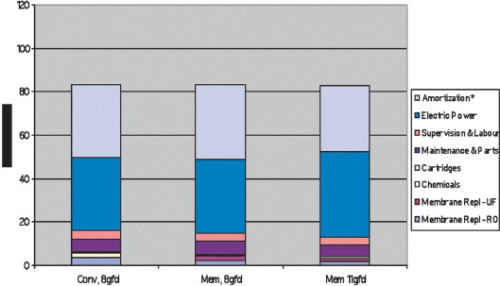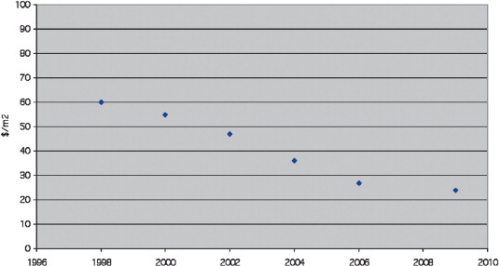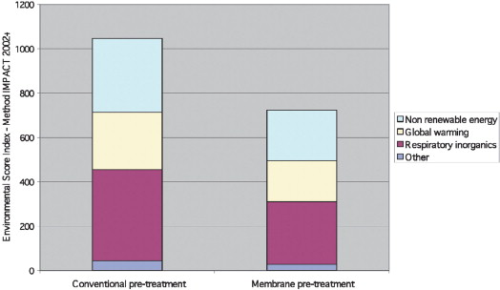


A pdf version of this article and the two previous articles in the series are available on the right-hand side under 'Downloads'
Background
Selection of pre-treatment technology for desalination in seawater reverse osmosis (SWRO) applications tends to polarise opinion. Conventional technology represents the status quo while membrane filtration adopts the role of the challenger, with a rapidly developing track record. Two issues limit the wider adoption of membrane pre-treatment. Firstly it is considered expensive in terms of capital cost, though it does provide operational cost savings. Secondly there are misgivings about whether membrane filtration alone provides sufficient pre-treatment, since preparing a feed suitable for RO requires more than the removal of fine particulates.
This article is the third in a series which will examine the issues involved in the selection of pre-treatment technology for SWRO, and consider the case for conventional and membrane pre-treatment options. The previous articles examined the issue of the treated water quality for the RO feed and integrity, while this article will cover cost and sustainability, focusing on the comparison between pre-treatment technologies.
The issues of cost and sustainability are linked. For example, a low energy process will have low operating costs combined with a low carbon footprint from greenhouse gas emissions. Such a process will be considered in a positive light in a sustainability assessment as well as being low in cost. However, many other issues in the cost and sustainability assessment are in conflict, with attempts to improve sustainability often adding expense and increasing the water cost. Furthermore, although cost factors can normally be precisely specified, the evaluation of sustainability is more subjective. A sustainability assessment includes a very large number of factors ranging from embedded carbon footprint in materials of manufacture to environmental and social impact. Whereas some of these factors can be quantified, others are given a nominal weighting, the impact of which is applied subjectively in the overall evaluation.
This article will examine the current status of cost evaluation in SWRO pre-treatment, and will consider the issues arising from the sustainability assessment, and indicate how different regions of the world are influenced by these assessments.
Desalination cost factors
The cost of water treatment can be evaluated from the materials used in treatment equipment and the operating cost of the process. To this the transfer cost of getting the source water to the treatment plant has to be added together with the energy cost distributing the treated water. In desalination treatment processes, pre-treatment costs are significant, and historically, pre-treatment by membrane filtration has been perceived as being expensive. However, if the Life Cycle Cost (LCC) is evaluated over 20 years, it turns out that operating costs are much more significant than the difference in capital cost due to the pre-treatment method, and that the dominant operating cost is energy.
According to Global Water Intelligence (GWI) [1], 2-3% of the world's energy is currently used for the treatment and transport of water. With the development of desalination and wastewater reuse, the use of energy in the water sector is expected to become a much more significant proportion of total energy use in the future. The problem will be exacerbated by the increasing energy use of water transfer to arid regions and the general demand for better treated water quality from all sources.
Although the energy cost of treatment is high for desalination, the cost of transport is also high, making desalination the best option for resource development in some circumstances [2]. For example, California spends 70% of its electricity on transferring water from the North of the State [1], which has provided the impetus to the development of desalination projects in the urban areas of the South [3].
Membrane filtration versus conventional
A Life Cycle Cost Comparison conducted in 2006 found that the increased capital cost of membrane filtration was paid for by operating cost savings for three different feed types, namely a Pacific Ocean feed, an Eastern Mediterranean feed, and a Gulf feed [4]. In the comparison, the Pacific Ocean feed had the lowest salinity at about 34,500 ppm Total Dissolved Solids (TDS), while the Gulf had the highest at 46,500 ppm.
For a medium scale plant with a 19 mld (5 MGD) RO output, membrane filtration added about 4% to capital cost (capex), as shown in Figure 1 (reflected in amortisation). However, if the RO is operated at the same conditions for both pre-treatment methods, savings in energy, chemicals, and RO replacement from the membrane pre-treatment option counter the increased capex. The figure shows an alternative option in which the RO post membrane pre-treatment is driven harder (since feed quality is better), saving capex, but at the expense of increased energy use. Both alternatives provide the same overall Total Water Cost (TWC) as the conventional pre-treatment.
In the review, membrane pre-treatment did better for Gulf feeds, due to the chemical cleaning savings offered by membrane pre-treatment, giving a reduction in TWC of about 4% compared to conventional pre-treatment.
In addition to the operating cost savings, membrane filtration was noted to have a significantly lower footprint than conventional pre-treatment, which can translate to a useful cost advantage especially where space is at a premium. Also membrane pre-treatment provides better on-stream time due to savings in downtime cleaning, and the ability to provide an absolute barrier during poor feed quality episodes. Footprint and downtime benefits were not given full benefit in the analysis, indicating that at the time of this evaluation there was an argument for membrane pre-treatment already developing even though the TWC advantage was limited. Indeed, the rapid expansion of membrane pre-treatment can be dated back to 2005/6, as will be discussed in the next article, confirming the market acceptance of this type of analysis.
Evolution of membrane filtration costs
Membrane filtration has become established in the water industry during the last 15 years. Initially, membrane prices were too high for widespread adoption, but since 2000 rapidly increasing take-up combined with increased competition has driven membrane prices down. Figure 2 shows the replacement prices for Siemens-Memcor membranes during this period, based on data from an AWWA webinar [5], updated for 2009 with recent market feedback. The trend is typical all of the UF/MF manufacturers, and shows a steady decline of membrane price to a level of just less than half the value a decade before. It should be noted that to compare prices between manufacturers, account needs to be taken of format and permeability differences, with design differences potentially affecting both capital and operating costs. The important take-away from the figure is therefore the rate of change for an example manufacturer rather than the absolute values.
The rate of decline is now beginning to level off, but the consequence of a further steady decrease in price between 2006 and 2009 is that the cost review discussed in the last section is now even more likely to favour membrane pre-treatment. Unsurprisingly, membrane manufacturers have been quick to confirm the cost effectiveness of UF/MF (for example [6]). However, this has now been confirmed by independents [7]. For example, Robert Huehmer of CH2M Hill has pointed out that membrane pre-treatment has benefited not only from lower membrane prices, but reduced system cost by use of polypropylene headers. In contrast, conventional filtration has increased in cost due to higher materials costs. Membrane pre-treatment therefore needs to be seriously considered for each pre-treatment prospect.
Sustainability
A sustainability assessment takes account of the total impact of a desalination plant. This includes consideration of materials used and their embedded carbon footprint, the environmental impact of operations, and the social or community impact. The latter category is difficult to quantify, but materials and operations can be determined with reasonable precision (though the analysis may become very involved as account is taken of knock-on impacts).
For conventional pre-treatment, the embedded carbon footprint of concrete is very high, and the footprint of the system is considerable, both of which weigh against sustainability. On the other hand, the media used in conventional pre-treatment is inexpensive and not subjected to significant processing, though it incurs a high transport debit due to its weight.
Membrane pre-treatment has low footprint and generally uses less material, but the membrane is an oil-derived product and it needs periodic replacement, which confers a sustainability burden. A lot of the membrane system components are plastic, which are also oil-derived.
With regard to environmental impact, the high public profile issues are based on the intake and outfall from the plant and their effect on the marine environment. The other environmental impact is in operation due to energy use, chemical addition, and membrane replacement. The most important single factor in a sustainability assessment will be to do with energy efficiency.
Membrane pre-treatment enables the option of running the RO at higher fluxes due to the improvement in feed quality. Costs may be minimised by high flux operation, since this reduces system size and capex at the expense of higher energy use, but this type of operation will rate poorly from a sustainability viewpoint. Figure 2 showed that this had a similar cost optimisation to the larger plant run at lower energy. For a positive sustainability assessment, it would be much better to opt for the gentler operating conditions, since Green House Gas (GHG) emissions will be more significant than the embedded material and footprint saving of a smaller plant.
The effect of the desalination plant on the marine environment is more difficult to quantify, though public perception would view this as probably the most important issue in sustainability and acceptability of the plant. Most plants take considerable effort to design intakes and outfalls which minimise impact, adding considerable cost to the project. For example, some Californian projects have up to twice the Total Water Cost of others with similar feed salinity due to efforts to ameliorate marine effects. An unintended consequence of this may be to significantly increase embedded carbon footprint.
A further environmental impact can be due to the use of chemicals and disposal of sludges. Membrane pre-treatment normally uses much less chemical than conventional pre-treatment. If coagulants are used, concentrations are typically one-third or less. In consequence, cost and carbon footprint of dosing chemicals are much reduced. Potentially of even greater impact in some locations, sludge disposal may be much reduced. Indeed, in the assessment of Australian projects, this has been a key factor which has favoured membrane pre-treatment, with membranes being selected so far for all bar one of a procession of projects.
In the Gulf region, the key environmental impact is caused by saline and chemical waste discharges into the sea. Though this has been accepted previously, the number of plants now in use or under construction is having a significant marine impact, which will provide an important driver for low chemical use operation made possible by membrane pre-treatment.
Environmental impact assessment
A German academic group has carried out a study to compare the environmental impact of SWRO with conventional and membrane pre-treatment [8]. The study reviews the whole life cycle of the product and process from raw material, to operating costs and distribution. The analysis takes account of raw materials used for production, as well as energy, waste, and other emissions. A similar approach is now being taken by consulting firms to advise the water industry of the lowest environmental impact solutions.
Figure 3 shows the comparison between the two pre-treatment options for a typical RO desalination scheme. The study shows that for this example, membrane pre-treatment reduces the environmental impact by about 33%. Important factors which weigh against conventional pre-treatment are high concrete use, large footprint, high embedded energy use, and high chemical use. However, it should be noted that sustainability assessments can yield variable results due to the subjective nature of some of the inputs. Assessments therefore need to be conducted on a case by case basis, focusing on the real issues of sustainability for the plant in question. This will always include energy, and may include issues such as concrete use, transport impact, discharge concerns, use of chemicals, and disposal of chemical sludge.
Conclusions
• Membrane pre-treatment for SWRO has been considered expensive, but a Life Cycle Cost assessment based on 2006 data showed that operating cost savings in energy, chemicals and reduced RO replacement rates paid for the increased capital cost.
• A reduction in membrane filtration prices since then has now made membrane pre-treatment competitive with conventional processes for many projects and potentially significantly lower in Total Water Cost.
• Sustainable assessments include a wide range of issues included embedded carbon footprint and environmental impact from energy and chemical use; a review by a German academic group indicated a 30% lower impact for membrane filtration compared to conventional pre-treatment.
• Most Australian SWRO plants have opted for membrane pre-treatment as a result of a rigorous sustainability and cost assessment; the majority of SWRO plants planned for California are also expected to use membrane pre-treatment due to cost competitiveness and lower environmental impact.
• Care needs to be taken in conducting sustainability assessments since a complete review includes soft issues which are subjective in their evaluation; assessments therefore need to be carried out on a case by case basis with a focus on the real issues of concern for a particular plant.
References
1 Water Technology Markets 2010; Key Opportunities & Emerging Trends, Global Water Intelligence, Section 2.1, 12-14, 2009.
2 GK Pearce, Desalination 222 (2008), pp. 66–73. Abstract | PDF (145 K) | View Record in Scopus | Cited By in Scopus (6)
3 Import or Desalinate, Water Desalination Report, p2-3, 25th June 2007.
4 Improving Total Water Cost of Desalination by Membrane Pre-treatment, Pearce, G K, Wilf, M, Bartels, C, IDA Conf Proceedings, Gran Canaria, Oct 2007.
5 Membranes in Wastewater Treatment, AWWA Webinar, 2nd Oct 2007.
6 Novel Trends in Dual Membrane Systems for Seawater Desalination: Minimum Primary Treatment and Low Environmental Impact Schemes, Busch, M, Chu, R, Rosenberg, S, IDA Conf Proceedings, Dubai, DB09-019 (2009).
7 MF/UF Pre-treatment in Seawater Desalination: Applications and Trends, Huehmer, R P, IDA Conf Proceedings, Dubai, DB09-253 (2009).
8 Comparative Life Cycle Assessment Study of Pre-treatment Alternatives for RO, Fritzmann, C et al, IDA Conf Proceedings, Gran Canaria, MP07-091, Oct 2007.






